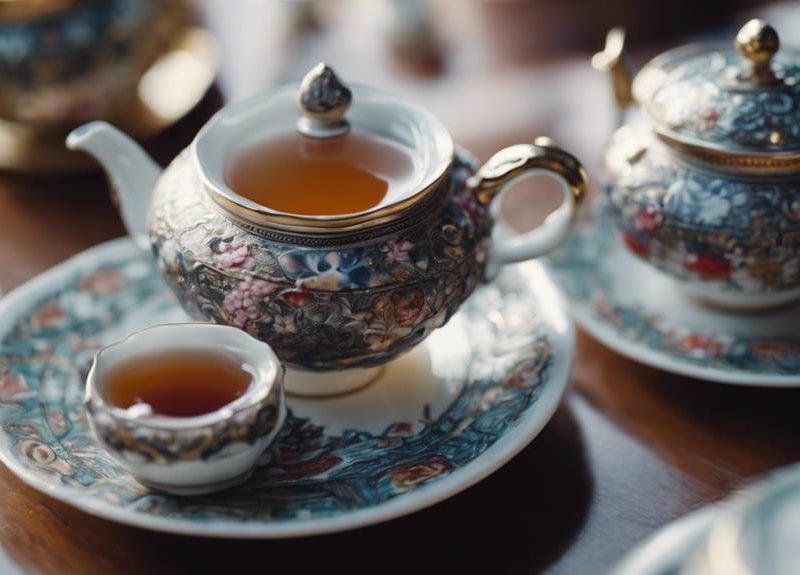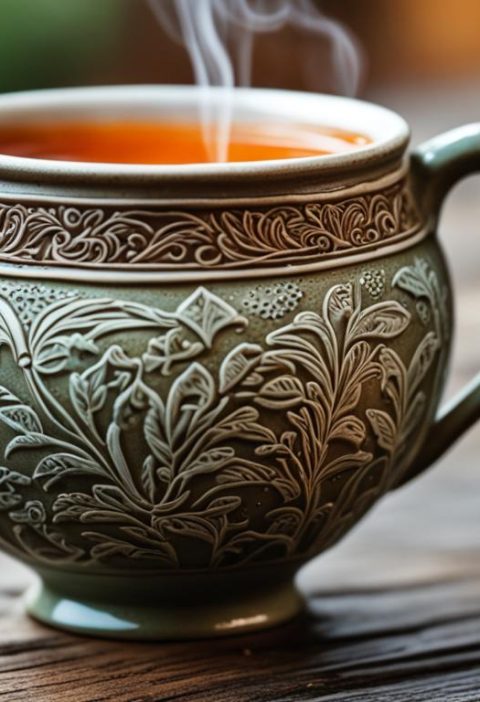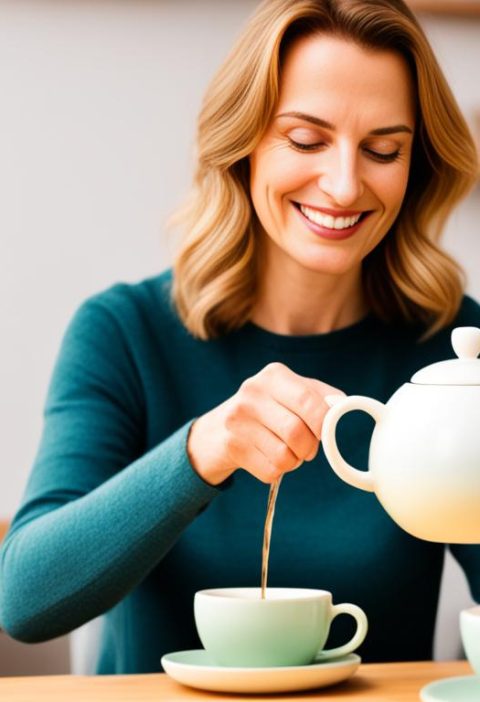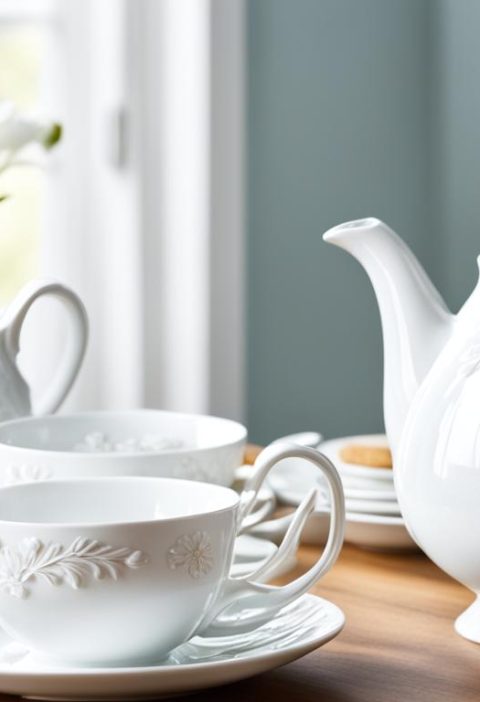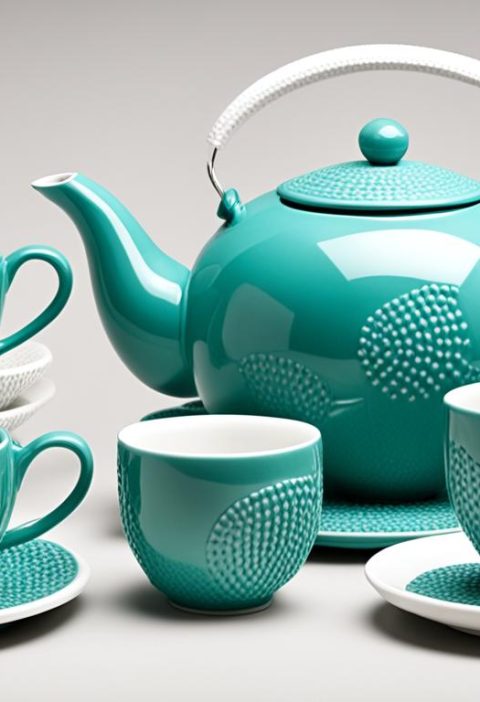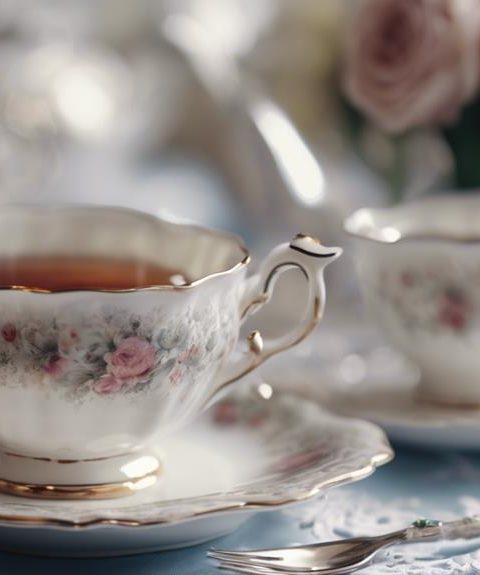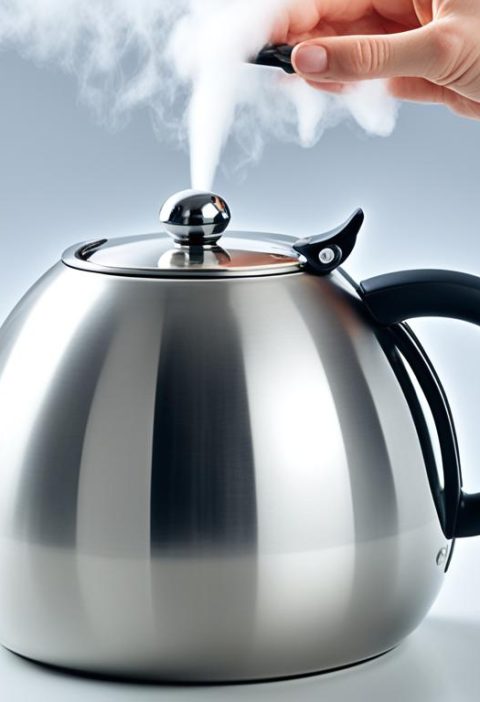Step into a world where tea sets, with their ancient roots in China, have evolved into a rich tapestry of global traditions and styles. From the Tang Dynasty's elaborate tea ceremonies to the intricate designs that emerged during the Industrial Revolution, tea sets have transcended mere functionality to become objects of both utility and artistry.
Explore the classic English designs that exude elegance, the Zen philosophy that underpins Japanese tea sets, and the opulent history of French influences on tea set aesthetics. Delve into the symbolism of Russian tea sets, which embody a spirit of hospitality, and discover how Middle Eastern tea pouring customs have elevated the act to an art form. African tea sets showcase a diverse array of cultural influences, reflecting the continent's rich heritage.
In the modern era, tea sets have embraced trends that blend technology with sustainability, offering enthusiasts a myriad of innovative possibilities to explore and appreciate.
Key Takeaways
Tea sets have a rich history dating back to ancient China, where they were initially used for medicinal purposes before becoming symbols of culture and tradition worldwide. Various regions such as China, Japan, England, France, India, Russia, the Middle East, Africa, Australia, and South America each have their unique tea set customs and practices. These traditional tea sets are crafted with intricate designs that reflect the cultural values, craftsmanship, and symbolism of their respective origins.
In the modern era, tea set trends have shifted towards sustainability, incorporating smart technology, offering customization options, and featuring multifunctional designs. This evolution from functional items to pieces of art highlights the adaptability and creativity of artisans on a global scale.
Origins of Tea Sets
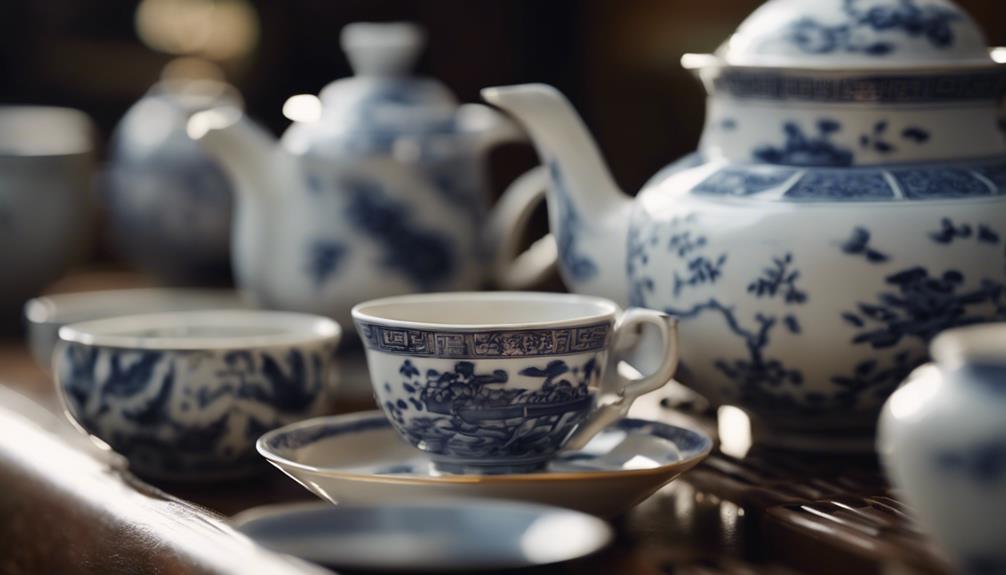
Tea sets have a rich history dating back to ancient China, where they were closely tied to the traditional practice of tea drinking. Initially used for medicinal purposes, tea gradually transformed into a social and cultural phenomenon. During the Tang Dynasty (618-907 AD), the popularity of tea ceremonies gave rise to the creation of specialized tea utensils, including the earliest forms of tea sets.
These early tea sets were characterized by their simplicity, typically comprising a teapot and cups crafted from materials like clay or porcelain. As the practice of tea drinking spread to countries like Japan and Korea, unique variations of tea sets emerged, each influenced by local customs and aesthetics.
Beyond their functional use, tea sets became symbols of status, artistry, and hospitality. The intricate designs and skilled craftsmanship of tea sets reflected the cultural values and traditions of the communities that used them. Over time, tea sets diversified in terms of style and materials, adapting to the diverse customs and tastes of different regions.
The evolution of tea sets showcases how a simple vessel for tea-drinking transcended its utilitarian origins to become an expression of cultural identity and artistic craftsmanship, resonating with people across various societies and time periods.
Evolution of Designs
Tea sets have transformed over the centuries, showcasing a rich tapestry of designs influenced by diverse cultures. Initially humble in their construction, early tea sets crafted from materials like clay or porcelain prioritized functionality over ornate embellishments.
As global connections expanded, tea sets absorbed a myriad of intricate designs inspired by various artistic traditions. For instance, 18th-century European tea sets boasted elaborate patterns and floral motifs mirroring the Baroque and Rococo artistic movements of the era.
The 19th century ushered in the Industrial Revolution, enabling mass production methods that democratized tea set ownership. These sets embraced simpler, more streamlined designs tailored to the burgeoning middle-class demographic.
In contemporary times, tea set design evolution continues, merging traditional elements with avant-garde influences. Today's designers experiment with a plethora of materials, shapes, and hues, crafting tea sets that cater to diverse tastes. This evolution underscores the adaptability and ingenuity of artisans across history.
Chinese Tea Set History
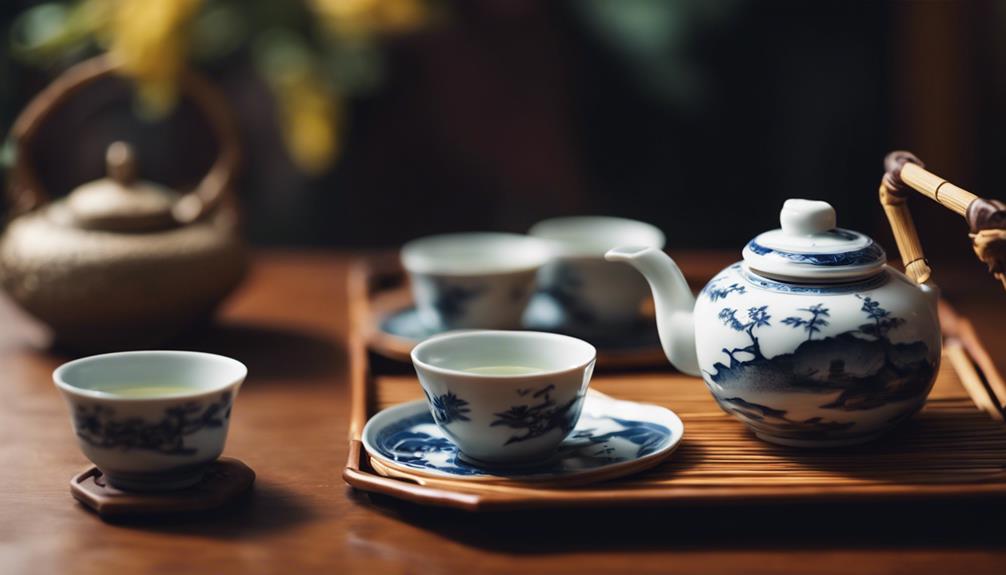
Chinese tea sets have a rich history deeply rooted in the Tang dynasty (618-907 AD), a period when tea culture flourished in China. The iconic porcelain teapots and cups that are synonymous with Chinese tea sets originated during the Song dynasty (960-1279 AD), setting a lasting standard for craftsmanship and design.
Among the most renowned types of Chinese tea sets is the Yixing clay teapot, crafted from a distinctive purple clay exclusively found in the Yixing region. These teapots are highly valued for their unique ability to enhance the flavor of tea with continued use. Each Yixing teapot is meticulously handmade by skilled artisans, showcasing the dedication to craftsmanship that defines Chinese tea culture.
In addition to Yixing teapots, traditional Chinese tea sets often include small cups, a tea tray, a tea strainer, and a tea pet believed to bring good luck. The intricate designs and vibrant colors of Chinese tea sets continue to captivate tea enthusiasts worldwide, reflecting the profound historical and cultural significance of tea in Chinese society.
Japanese Tea Set Traditions
Discover the intricate world of Japanese tea sets, rooted in the traditional tea ceremonies that date back centuries. These tea sets aren't just functional vessels but pieces of art that embody profound cultural significance.
Japanese tea sets have their origins in the refined tea ceremonies, where every element plays a crucial role in the ritual. From the delicate teacups to the elegant teapots and the serene tea bowls, each piece is crafted with meticulous attention to detail.
The artistry of Japanese tea sets reflects the rich cultural heritage of Japan, blending elements of Zen philosophy, nature appreciation, and traditional craftsmanship. The designs often feature motifs inspired by nature, such as cherry blossoms, bamboo, or waves, symbolizing harmony and tranquility.
In a traditional Japanese tea ceremony, known as 'chanoyu' or 'sado,' the host prepares and serves matcha, a powdered green tea, to guests in a serene and meditative setting. The careful choreography of movements and the use of specific tea utensils are meant to create a harmonious and peaceful atmosphere.
Each element of a Japanese tea set, from the teapot to the tea scoop, has its own symbolic meaning and purpose in the tea ceremony. For example, the teapot, or 'kyusu,' is designed for optimal brewing and pouring, while the tea whisk, or 'chasen,' is used to froth the matcha to a smooth consistency.
Tea Ceremony Origins
The Japanese tea ceremony, also known as 'chanoyu' or 'sado,' originated in Japan and has profoundly impacted the design of Japanese tea sets. This revered tradition, dating back to the late 12th century, embodies values of harmony, respect, purity, and tranquility.
Evolving into a spiritual practice emphasizing mindfulness and connection, the ceremony involves precise movements where each gesture and object carries symbolic significance. Japanese tea sets, meticulously crafted with attention to detail, reflect the principles of wabi-sabi – finding beauty in imperfection and impermanence.
Rooted in Zen Buddhism, the ceremony's evolution was shaped by tea masters like Sen no Rikyu over the centuries.
Art of Teaware
The exquisite artistry and meticulous craftsmanship of Japanese tea sets showcase the profound traditions and spiritual significance of the tea ceremony. Each component of a traditional Japanese tea set, such as the teapot (kyusu) and the tea bowl (chawan), is intricately designed to elevate the tea-drinking experience. Japanese artisans meticulously infuse cultural motifs like cherry blossoms and serene landscapes into their creations, paying homage to heritage and aesthetics.
These tea sets transcend mere functionality; they serve as masterpieces of art, embodying the core principles of harmony, respect, purity, and tranquility intrinsic to the Japanese tea ceremony. Engaging with a Japanese tea set transcends a simple act of tea consumption; it involves partaking in a time-honored ritual that fosters mindfulness and communal connection, enriching the soul and spirit through every sip.
Cultural Significance
Immerse yourself in the intricate world of traditional Japanese tea sets, where cultural richness is woven into every design. These tea sets hold profound significance, reflecting centuries-old traditions and rituals that have shaped Japanese culture. Let's delve into the cultural aspects encapsulated in these exquisite teaware:
- Zen Philosophy: Japanese tea sets serve as embodiments of Zen Buddhism's core principles, promoting simplicity, tranquility, and mindfulness during tea ceremonies.
- Harmony and Respect: In Japan, tea ceremonies symbolize a profound sense of harmony and respect, where each movement and gesture carries deep meaning, fostering connections and mindfulness among participants.
- Seasonal Influences: Japanese tea sets often feature seasonal motifs such as cherry blossoms in spring or maple leaves in autumn, paying homage to the beauty of nature and the cyclical passage of time.
English Tea Set Elegance
Explore the enduring charm of English tea sets, renowned for their timeless designs that bring an air of sophistication to any tea gathering.
These sets showcase a legacy of exquisite porcelain craftsmanship, embodying elegance and grace in every piece.
Delve into the history and cultural significance of English tea sets, a symbol of refinement and tradition in the world of tea ceremonies.
Classic English Designs
Experience the allure of Classic English Designs through their intricate patterns and enduring elegance showcased in tea sets. These designs, revered for centuries, embody sophistication and grace. Classic English tea sets often boast delicate floral motifs and lavish gold accents, elevating any tea time gathering with a touch of opulence.
Revel in the exquisite patterns adorning classic English tea sets.
Admire the timeless sophistication these designs bring to your tea table.
Embrace the grace and luxury associated with classic English tea sets.
Teatime Sophistication
Immerse yourself in the refined charm and sophistication embodied by English tea set elegance, where intricate craftsmanship and timeless beauty converge to enhance your teatime experience.
The English tea set transcends mere functionality; it symbolizes grace and tradition, carrying a legacy of elegance passed down through generations.
Each delicate cup and saucer, meticulously designed teapot, and ornate sugar bowl showcase intricate floral patterns and gold accents, exuding luxury and sophistication that set the stage for your afternoon tea rituals.
Whether savoring a quiet moment alone or hosting a gathering of friends, the English tea set infuses an air of sophistication and refinement into any occasion, making each sip a truly special experience.
Heritage in Porcelain
Immerse yourself in the rich heritage of English tea sets, where the exquisite elegance of porcelain craftsmanship has endured through the ages. Porcelain English tea sets are a symbol of sophistication and timeless beauty, elevating any tea gathering with their air of elegance. Crafted by skilled artisans, these delicate sets are treasured for generations.
Exploring the heritage of porcelain in English tea sets unveils:
- Precision-hand-painted intricate floral patterns.
- Luxurious fine gilding details that enhance the set's opulence.
- Crafted delicate handles and spouts showcasing the artistry of the era.
French Tea Set Influence
French tea sets, known for their intricate details and elegant designs, have been pivotal in shaping the realm of tea culture. These exquisite sets embody sophistication and artistry, reflecting the opulent history and luxury associated with the tradition of tea drinking. Adorned with delicate patterns, ornate handles, and exceptional craftsmanship, French tea sets captivate tea enthusiasts globally.
Originating in the 17th century, French tea sets emerged during the rise of tea's popularity among the French aristocracy. Influenced by Chinese and Japanese tea customs, French artisans ingeniously blended Eastern and Western aesthetics in crafting these sets. This fusion not only garnered admiration in France but also spread across Europe, showcasing the French mastery in porcelain and ceramic production.
In contemporary times, French tea sets continue to inspire tea rituals and elevate the tea-drinking experience. Whether indulging in a leisurely afternoon tea or hosting a formal gathering, incorporating a French tea set imparts an air of refinement and grace to the occasion. The legacy of French tea sets endures as a symbol of timeless beauty and functionality in the rich tapestry of tea culture.
Indian Tea Set Heritage
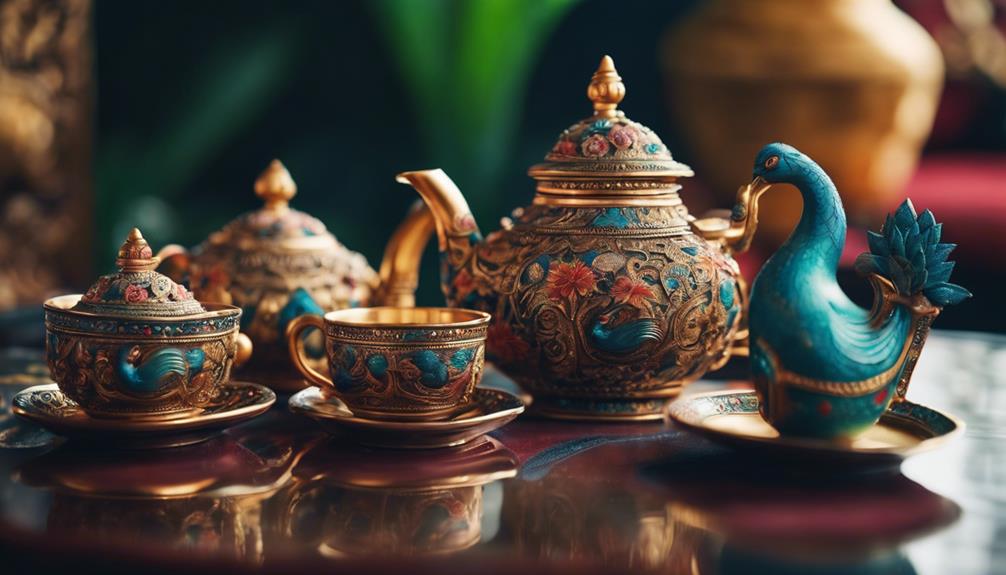
Explore the intricate designs and rich cultural significance of Indian tea sets, showcasing the artistic heritage and traditional craftsmanship of India. These tea sets highlight the diverse styles and motifs that make them unique and special in Indian culture.
Indian tea sets are renowned for their exquisite details and cultural symbolism. They often feature intricate patterns inspired by nature, mythology, and religious beliefs, reflecting the country's deep-rooted traditions and artistic expressions.
The tea sets typically include a teapot, cups, saucers, and sometimes a sugar bowl and creamer, all crafted with meticulous attention to detail. The materials used range from delicate porcelain to sturdy clay, each representing different regional styles and techniques.
In Indian homes, serving tea is a ritual that fosters hospitality and connection among guests. The act of pouring and sharing tea from these beautifully crafted sets is a gesture of warmth and respect, embodying the essence of Indian hospitality.
The motifs found on Indian tea sets vary widely, from floral patterns symbolizing growth and prosperity to geometric designs representing harmony and balance. These motifs not only add aesthetic appeal but also carry deeper meanings rooted in Indian cultural beliefs and traditions.
Whether adorned with vibrant colors or intricate etchings, Indian tea sets are a fusion of artistry and functionality, making them both visually appealing and practical for everyday use. They serve as a testament to India's rich artistic heritage and the skillful craftsmanship passed down through generations.
Understanding the cultural significance and craftsmanship behind Indian tea sets provides a glimpse into the intricate world of Indian art and design, inviting appreciation for the diverse and vibrant traditions that shape the country's cultural identity.
Indian Tea Set Designs
Indian tea set designs are a testament to the rich heritage of craftsmanship and cultural influences in India. They feature a captivating fusion of traditional aesthetics and contemporary elements, showcasing a unique blend of artistry. Here are some distinctive characteristics of Indian tea set designs:
- Intricate patterns and motifs influenced by the mesmerizing architecture and vibrant nature of India.
- A vivid color palette comprising deep blues, rich greens, and glowing reds, reflecting the diverse cultural tapestry of the country.
- Materials like brass, copper, and silver are commonly used, often embellished with exquisite engravings and decorative details.
Indian tea sets not only serve a practical function but also serve as exquisite pieces of art that encapsulate the profound history and artistic traditions of India.
Cultural Significance of Tea Sets
Tea sets in India serve as more than just functional items; they're imbued with deep cultural significance that reflects the rich tapestry of Indian traditions. These sets symbolize hospitality, warmth, and respect in Indian culture, going beyond their basic purpose of serving tea.
The design and use of tea sets in India vary across regions, each showcasing unique customs and aesthetics specific to that area. Here are some key elements commonly found in Indian tea set designs:
- Brass Material: Frequently utilized in tea sets, brass symbolizes prosperity in Indian culture.
- Floral Motifs: Elaborate floral designs on tea sets represent beauty and the connection to nature.
- Elephant Handles: Handles shaped like elephants symbolize strength and wisdom in Indian symbolism.
- Vibrant Colors: Bright colors such as red and gold used in tea sets signify joy and celebratory occasions.
- Engraved Patterns: Detailed carvings on tea sets showcase exquisite artisanal craftsmanship.
These elements collectively contribute to the cultural significance of Indian tea sets, embodying the values and aesthetics of India's diverse heritage.
Russian Tea Set Legacy
The legacy of tea sets in Russia intertwines deeply with its diverse cultural heritage and longstanding traditions. Tea occupies a cherished position in Russian customs, serving as a beloved ritual that has endured for centuries. Russian tea sets not only serve a practical function but also stand as exquisite works of art, reflecting the nation's mastery of craftsmanship and meticulous attention to detail.
- Samovar: At the heart of Russian tea culture lies the samovar, a traditional metal urn utilized to heat and boil water for tea. Symbolizing warmth and conviviality, the samovar often takes center stage in social gatherings, embodying the spirit of hospitality and communal bonding.
- Podstakannik: Essential to the Russian tea experience, the podstakannik is a metal holder for tea glasses, designed to maintain the warmth of the beverage while shielding the drinker's hands from the heat. A fixture in Russian tea ceremonies, the podstakannik adds a touch of elegance to the act of tea drinking.
- Zavarka: A diminutive teapot employed for brewing concentrated tea, the zavarka plays a vital role in the Russian tea-making process. By facilitating the preparation of robust and flavorful tea, this element enhances the richness and intensity of the tea-drinking experience.
Middle Eastern Tea Set Customs
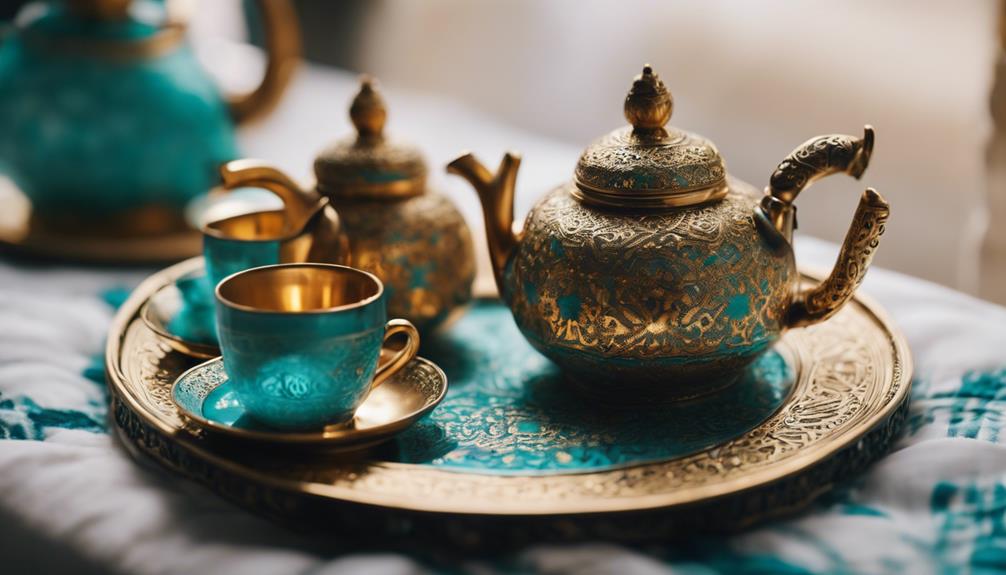
Middle Eastern tea set customs embody a vibrant cultural heritage, rich in symbolism and artistry, reflecting the region's deep-rooted traditions. Tea holds a significant place in Middle Eastern hospitality, symbolizing warmth and welcome. The intricate tea sets in this region serve as a testament to the value placed on social gatherings and hospitality.
The traditional Middle Eastern tea set comprises a teapot, delicate glasses, and a decorative tray. The teapot, crafted with elaborate designs, is often fashioned from materials like brass, silver, or porcelain, showcasing both craftsmanship and symbolism. Silver, for instance, is believed to enhance the flavor of the tea.
In Middle Eastern tradition, tea is commonly served sweetened with sugar or honey. The act of pouring and presenting tea is considered an art form, guided by specific customs and rituals. It's customary for guests to be served tea first, signifying respect and gratitude towards the host.
African Tea Set Diversity
African tea sets, reflecting a diverse blend of cultural influences and artistic styles, offer a rich tapestry of heritage and traditions across the continent. Crafted from materials like clay, porcelain, and metal, these tea sets showcase the continent's varied craftsmanship and traditional practices.
Intricate patterns and symbols, each holding symbolic meaning tied to local cultures and beliefs, adorn these tea sets. The shapes vary widely, from traditional round pots to uniquely designed cups and saucers, highlighting the creativity and innovation of African artisans.
Exploring African tea sets provides a unique window into the continent's cultural richness and the artistic expressions of its people.
Australian Tea Set Culture
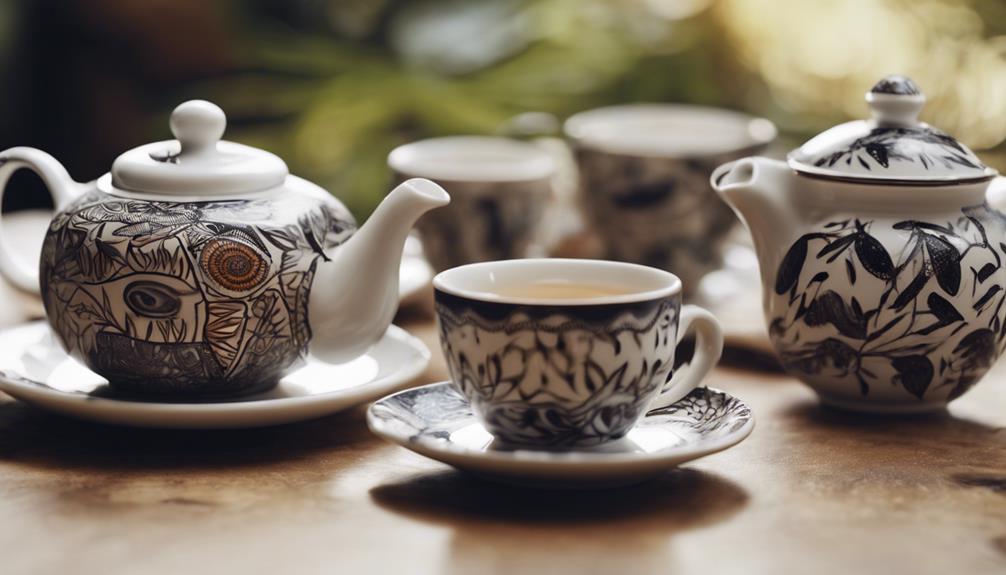
Australian tea set culture embodies a rich tapestry of indigenous artistry and contemporary influences, showcasing the diverse heritage and creativity of the continent. Tea sets in Australia serve not only as functional items but also as cultural artifacts with deep significance. The designs draw inspiration from Aboriginal art, native flora, fauna, and modern Australian aesthetics, blending tradition with innovation.
In Australian tea set culture, diverse materials, designs, colors, and styles come together to create a unique experience. Ceramic sets feature intricate Aboriginal art patterns in earth tones, while porcelain sets exhibit minimalist designs inspired by native flora in vibrant hues. Wooden sets showcase geometric shapes in natural tones, adding a rustic touch, and glass sets highlight coastal themes in elegant blue and green hues.
Each tea set in Australia tells a story of heritage and creativity, bridging the past and the present through a fusion of traditional and contemporary elements.
South American Tea Set Varieties
South American tea sets showcase a fascinating fusion of cultural influences and artistic expressions, reflecting the region's rich history and diverse traditions. Here are some insights to delve into this unique world:
- Materials: South American tea sets exhibit a wide array of materials such as delicate porcelain, vibrant ceramics, and intricate silverwork. Each material holds its own cultural significance, enhancing the beauty and uniqueness of the tea set.
- Designs: Drawing inspiration from indigenous motifs, colonial legacies, and modern inspirations, the designs of South American tea sets are a testament to the creativity of local artisans. These sets feature colorful patterns, intricate engravings, and innovative shapes that blend tradition with contemporary aesthetics.
- Ceremonies: Tea-drinking rituals across South America vary by region, influencing the design and use of tea sets. Each country has its unique customs and ceremonies surrounding tea consumption, adding a layer of cultural depth to the artistry of the tea sets.
Modern Tea Set Trends
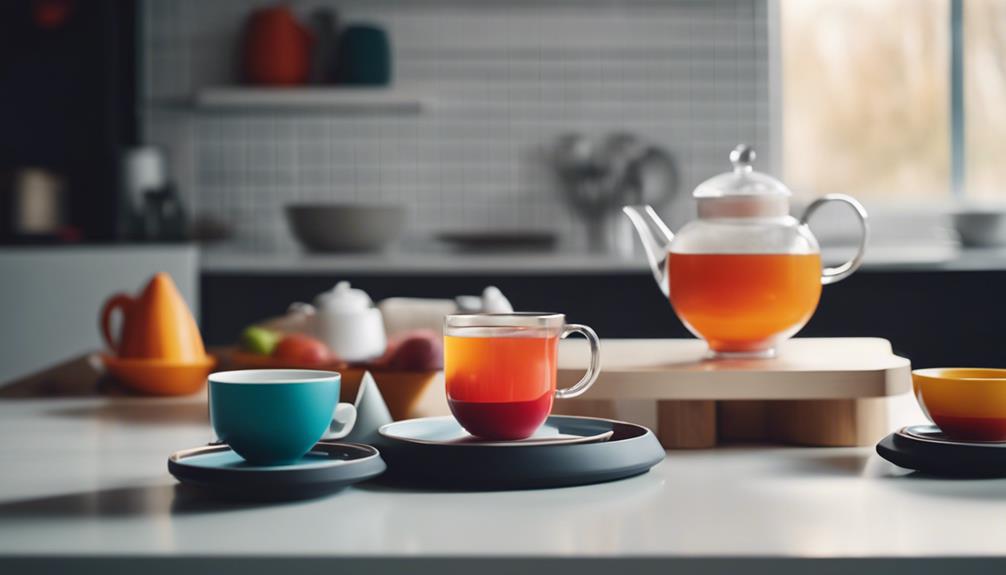
In the realm of modern tea sets, a fusion of innovation and style is driving the latest trends. These sets aren't just functional but also artistically appealing, designed to meet the demands of today's tea aficionados. Smart technology plays a significant role, with features like temperature control settings and Bluetooth connectivity for playing music enhancing the tea-drinking experience. The aesthetic appeal of these contemporary tea sets lies in their sleek, minimalist designs that harmonize effortlessly with modern home decor.
Moreover, sustainability is a core focus in the design of modern tea sets, with materials like bamboo, glass, and recycled ceramics being popular choices. These eco-friendly options cater to the growing concern for environmental impact among consumers.
A notable trend is the customization of tea sets, allowing individuals to mix and match pieces to curate a unique collection that mirrors their personal style. Whether it's vibrant colors or whimsical patterns, the customization options are endless, providing a personalized touch to the tea ritual.
Furthermore, multipurpose tea sets are gaining traction, offering versatility beyond just serving tea. Teapots that double as flower vases or cups suitable for both tea and espresso cater to those seeking practical and space-saving solutions in their kitchen. This adaptability addresses the evolving needs and preferences of tea enthusiasts worldwide, reflecting the dynamic nature of tea culture.
Frequently Asked Questions
How Do Different Cultures Incorporate Tea Sets Into Traditional Ceremonies?
Tea sets hold significant importance in various cultural traditions, embodying values of hospitality, respect, and connection. They are utilized in ceremonial practices, marking special events, and fostering meaningful interactions among individuals spanning different generations.
In Chinese culture, tea sets are integral to traditional tea ceremonies, symbolizing harmony, balance, and mindfulness. These sets typically include a teapot, tea cups, a tea tray, and other accessories, each serving a specific purpose in the ritual.
Furthermore, in Japanese culture, tea sets are central to the revered tea ceremony known as "chanoyu" or "sado." These sets consist of a teapot, teacups, a tea caddy, a water jar, and a bamboo whisk, all meticulously arranged to facilitate a meditative and serene tea-drinking experience.
Across cultures, the act of serving tea from these sets is a symbol of warmth, friendship, and reverence, creating a shared moment of connection and tranquility among participants. The intricate designs and craftsmanship of tea sets reflect the cultural values and aesthetics of the communities they originate from, making them not just vessels for tea but also works of art that carry deep cultural significance.
Are There Any Superstitions or Beliefs Associated With Tea Sets?
In various cultures, tea sets hold symbolic significance, with beliefs and superstitions surrounding their use. For instance, it is considered unlucky to use chipped cups while serving tea, as they may bring bad luck. Additionally, in some traditions, empty teacups are seen as a sign of imminent visitors or guests arriving. These cultural practices and superstitions enrich the act of serving tea with deeper meanings and connections to beliefs and customs.
What Materials Are Used in Modern Tea Set Production?
Porcelain, bone china, glass, and ceramic are commonly utilized in modern tea set production. These materials provide a balance of strength, sophistication, and adaptability, making them favored choices for creating contemporary tea sets.
Can Tea Sets Be Customized or Personalized for Special Occasions?
Customizing or personalizing tea sets for special occasions is a wonderful way to create a unique and memorable gift. By incorporating distinct designs, colors, or engravings, you can add a personal touch that enhances the significance of the tea set. This customization allows for a more tailored and thoughtful present, making the experience even more special.
How Do Tea Enthusiasts Store and Display Their Tea Sets at Home?
Tea enthusiasts take great care in storing and showcasing their tea sets at home. They often use shelves, cabinets, or dedicated display areas to exhibit their collection, adding a touch of elegance to their living space. This display not only organizes their tea sets but also serves as a statement of their passion for tea culture and appreciation for fine craftsmanship.
Conclusion
When enjoying your tea, reflect on the diverse cultural influences that have shaped the exquisite tea sets we cherish today.
From the intricate craftsmanship of Chinese tea sets to the refined elegance of English tea sets, each set encapsulates a unique narrative.
Whether you're drawn to contemporary designs or traditional aesthetics, the world of tea sets offers a rich tapestry of styles to admire and embrace.
Here's to celebrating the historical significance and artistic beauty of tea sets from various corners of the world!
